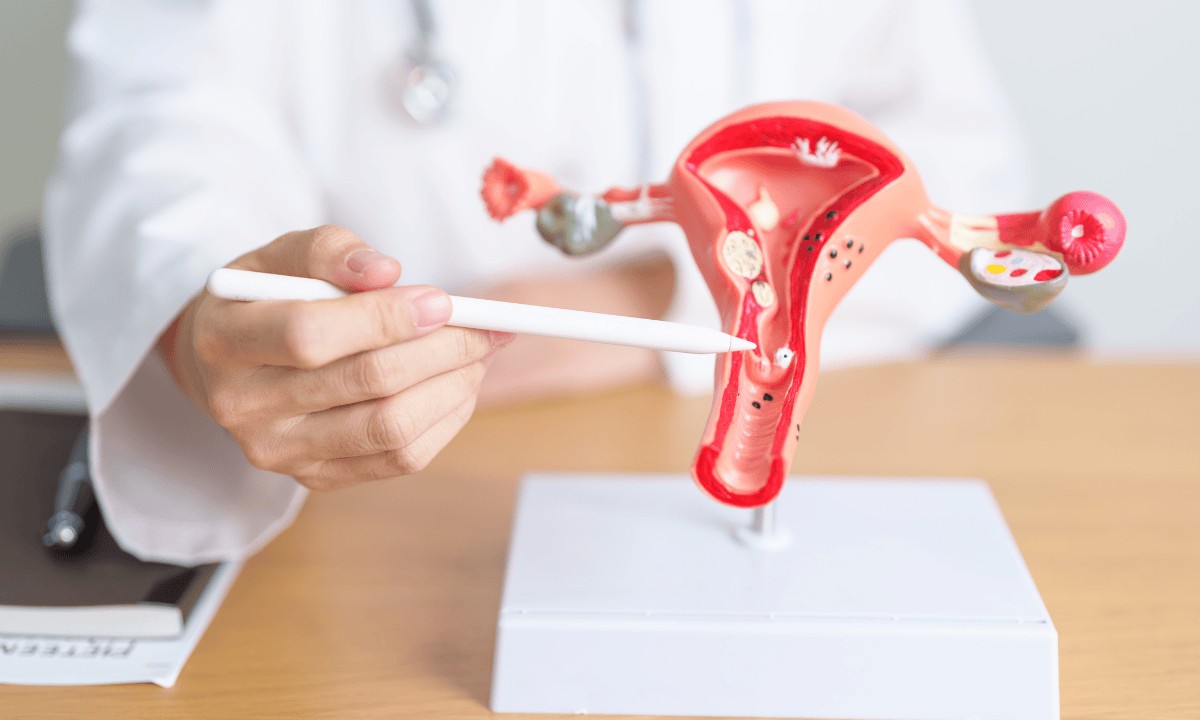Perhaps lately you've noticed something worrying, such as vaginal bleeding between your periods or unusual discharge. Then, when you visited an obstetrician or gynaecologist (O&G), they told you that you have a cervical polyp.
It's completely natural to feel concerned when you receive this diagnosis, and you may wonder whether it means you have cancer. To help you understand these abnormal growths better, let's take a closer look at what's happening in your body and what this means for your reproductive health.
What is a cervical polyp?

A cervical polyp is a small growth that develops on the surface of the cervix (the lower part of the womb that connects to the vagina). These polyps can vary in size from a few millimetres to a few centimetres in diameter and can occur alone or in groups. They are usually cherry red, reddish purple, or greyish white in colour.
Although cervical polyps are usually noncancerous, in rare cases they can be precancerous (abnormal cell changes that could become cancerous if left untreated). While it may sound concerning, when detected early, these precancerous changes can be treated before they develop into cancer. There are two types of cervical polyp:
Ectocervical polyp:
These develop on the outermost layer of the cervix and are more common among postmenopausal women.
Endocervical polyp:
These are the most common type of polyps that develop from cervical glands inside your cervical canal and are more common in premenopausal women.
What causes cervical polyps?
Even though the exact cause of cervical polyps is still unknown, there are several factors that may contribute to their development. These include:
Chronic inflammation of the cervix
An abnormal response to increased levels of oestrogen hormone
Clogged blood vessels in the cervix
Cervical polyps are most commonly found in women over 40 who have given birth and rarely occur before age 20.
What are the symptoms of cervical polyps?
While most cervical polyps don't cause any noticeable symptoms, when symptoms do occur, you may experience:
Bleeding after sexual intercourse
Foul-smelling vaginal discharge
Abnormal vaginal bleeding, like between periods or after menopause.
If you are experiencing any of the mentioned symptoms and they persist or worsen, schedule a consultation with an O&G specialist. At Thomson Women's Clinic, our specialists can help determine the underlying cause of your symptoms and provide a tailored treatment plan.
Our O&G specialists
Loading...
How are cervical polyps diagnosed?
Cervical polyps are usually found during routine pelvic examinations or Pap tests. Your healthcare provider will be able to see a polyp once they insert a speculum, a device that gently opens the walls of your vagina, to get a clear view of your cervix.
If a polyp is found, your doctor will usually perform a biopsy and send the tissue to a laboratory for analysis. This examination is an important step to confirm that the polyp is noncancerous and rule out any precancerous or cancerous changes.
What treatments are available for cervical polyps?
To treat cervical polyps, your doctor will need to remove them. If the polyps are small, removal can be performed right in the clinic. Your doctor will use a tool called polyp forceps to grasp the polyp and gently twist it off your cervix.
If the polyp is large, your doctor may recommend a minor surgical procedure known as a polypectomy. Prior to the procedure, your doctor will administer anaesthesia to numb your cervix and ensure your comfort.
If there isn’t a base or stalk to grasp, or if the polyp is large, your doctor may use a loop electrosurgical excision procedure (LEEP). This surgical method uses a wire loop heated by an electric current to remove the polyp from the cervical surface.
After the procedure, you may experience some bleeding and cramping during or after it. Over-the-counter painkillers, such as paracetamol or ibuprofen, can help relieve any discomfort.
Cervical Polyp Treatment at Thomson Medical
It can be difficult to deal with symptoms like unusual bleeding or finding out you have cervical polyps, but remember that you're not alone. At Thomson Women's Clinic, our specialists provide thorough support, from diagnosis to treatment and follow-up care. We're here to support you with:
Specialists to guide you through your treatment options
Regular check-ups and monitoring to ensure you receive the best possible care
Specialists who understand your concerns about pain, and may offer anaesthesia to ensure your comfort prior to the procedure
In addition, we also offer other procedures to help treat cervical polyps, which is:
Polypectomy:
Polypectomy procedures cost between SGD 767 and SGD 4,300 for inpatient surgeries, depending on whether you choose a public or private hospital.
However, there may be extra costs for expenses like pre-surgery consultations, imaging tests (like X-rays or CT scans), medications, and follow-up appointments after surgery.
Are there any subsidies for polypectomy?

Yes, there are several schemes in Singapore that can help offset the total costs of polypectomy. These include MediSave, MediShield Life, and Integrated Shield Plans. Each offers different levels of coverage for your polypectomy depending on your eligibility and insurance arrangements.
MediSave
MediSave is a national medical savings scheme that allows Singaporean citizens and permanent residents to use their savings for hospitalisation expenses.
For hospitalisation, you can use up to SGD 1,130 per day for the first two days and SGD 400 per day for subsequent days for inpatient hospital charges. These charges include daily ward changes, treatment fees, investigations, and medications.
For day surgeries, you can use up to SGD 830 per day for hospital charges, which include daily ward charges, treatment fees, investigations, and medicines.
MediShield Life
MediShield Life is a basic health insurance plan for all Singaporeans and PRs, designed to help pay for large hospital bills and selected costly outpatient treatments. It will cover a portion of the surgical and hospitalisation costs for the polypectomy, and, similar to MediSave, there are claim limits.
For hospitalisation, the claim limits are SGD 830 per day for normal wards and SGD 5,140 for ICU wards, which include an additional SGD 800 per day for the first two inpatient days.
Integrated Shield Plans
Integrated Shield Plans (IPs) are private insurance policies that offer additional coverage beyond what is provided by MediShield Life. They can cover a larger portion of your hospital bill, especially if you opt for private hospitals or higher-class wards.
Many IPs also offer “as-charged” benefits, meaning they cover the actual bill amount, subject to policy terms and annual limits. Coverage details and claim limits vary depending on the insurer, the specific plan and the extra riders purchased.
This price was last updated in June 2025. Therefore, polypectomy costs may have changed since then. For more information, visit our polypectomy cost guide or contact our medical concierge.
FAQ
Are cervical polyps common?
Yes, cervical polyps are relatively common. They are most frequently found in women over 40 who have had more than one child but can develop at any age during the reproductive years. The vast majority of cervical polyps are benign (non-cancerous). Cancerous polyps are rare, but the risk is slightly higher in postmenopausal women.
How are cervical polyps diagnosed?
Cervical polyps are typically discovered during routine pelvic examinations or Pap smear tests, as they're usually not something you can see or feel yourself. They may also be detected during investigations for abnormal bleeding.
During the examination, your doctor will insert a speculum into your vagina to get a clear view of your cervix. Cervical polyps can often be identified visually during this examination. If a polyp is found, your doctor will usually remove it and send the tissue to a laboratory for examination.
What can you expect after polyp removal?
You may experience mild cramping and light vaginal bleeding or spotting for a few days afterwards. Over-the-counter painkillers, such as paracetamol or ibuprofen, can help relieve any discomfort.
Your doctor will advise you to avoid sexual intercourse and tampon use for at least two to three weeks after the procedure to allow proper healing. Most women find they can return to their normal daily activities within a day or two.
Will I get a cervical polyp again after removal?
Although it's uncommon for polyps to return after they have been removed, it can happen. Women who have previously had cervical polyps are slightly more likely to develop them again in the future.
Will cervical polyps affect pregnancy?
While most cervical polyps are benign and do not pose a significant risk during pregnancy, they can sometimes cause vaginal bleeding or discharge. In most cases, removal is deferred until after delivery to avoid potential complications, unless the polyp is causing significant bleeding or other concerning issues.
If you are trying to conceive, it is recommended that the polyp be removed before trying for a baby or undergoing fertility treatment, as it can potentially interfere with the passage of sperm or the implantation of an embryo.
How can I prevent cervical polyps?
While it is difficult to prevent cervical polyps entirely, because some of the contributing factors – such as hormonal responses – are difficult to control, there are steps you can take to reduce your risk, such as:
Practice safe sex by using condoms to reduce the risk of contracting STIs
Promptly address any vaginal infections or inflammation with your healthcare provider
Attend regular pelvic examinations and Pap smear screenings, as these can facilitate early detection and treatment
The information provided is intended for general guidance only and should not be considered medical advice. For personalised recommendations for your specific conditions, schedule a consultation with our O&G specialist at Thomson Women’s Clinic.
For more information, contact us:
Thomson Specialists (Women's Health)
Thomson Women's Clinic (TWC)
- Novena:
6592 6686 (Call), 8611 8986 (WA) - Bukit Batok:
6569 0668 (Call), 8686 3525 (WA) - Choa Chu Kang:
6893 1227 (Call), 8282 1796 (WA) Jurong:
6262 8588 (Call), 6262 8588 (WA)- Katong (female doctor):
6970 2272 (Call), 8611 9020 (WA) - Punggol:
6243 6843 (Call), 8811 0328 (WA) - Sembawang: 6753 5228
- Sengkang: 6388 8125
- Serangoon (female doctor): 6382 3313
- Tampines: 6857 6266
- Tiong Bahru: 6276 1525

